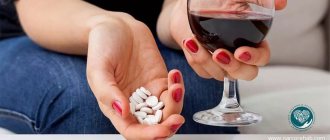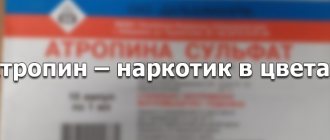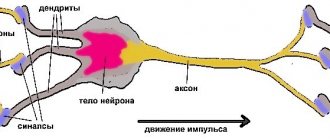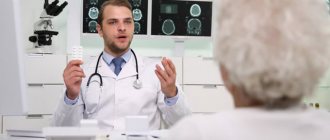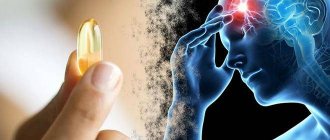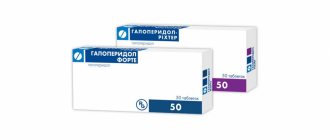Barbiturates
There is a saying that any medicine without proper dosage turns into poison. Barbiturates include barbituric acid, which is addictive when used over a long period of time. Intoxication with barbiturates includes several stages and a difficult period of “coming off”. In order to repeat the past experience of barbiturate intoxication, a person looks for ways to obtain drugs illegally and even goes to theft.
What it is
Barbiturates are a group of drugs containing barbituric acid. Such medications are used for insomnia and exacerbation of certain mental illnesses.
Substances taken orally are absorbed into the small intestine, and when they enter the bloodstream they accumulate in liver cells. This acid causes a disruption in the transmission of nerve impulses, blocks the production of acetylcholine (this causes a sedative effect) and reduces the activity of GABA. Metabolites of active substances accumulate in cells and tissues, leading to intoxication of the body.
Composition of barbiturates
On the official list, about 50 drugs of this group are commercially sold. Barbiturates are synthesized using a combination of urea and dialkylmalonic acid esters. In some cases, urea is mixed with dicyandiamide.
There are ultra-short, short, medium and long-acting drugs. Long-acting medications are most often used for epilepsy.
Formula
Barbituric acid has the formula C4H4N2O3. Self-administration of this group of medications can lead to addiction and serious pathologies of internal organs. It is necessary to know where barbiturates are contained in order to prevent possible negative consequences from use and check the current dosage with your doctor.
List of barbiturates without prescription
When severe insomnia or a panic attack occurs, pharmaceutical drugs based on barbiturates are often used. These include:
- Corvalol (an effective remedy for relieving functional disorders of the cardiovascular system and insomnia. Contains phenobarbital);
- Valocordin (used to relieve cardiac disorders and normalize the functioning of the central nervous system);
- Andipal is a substance for the relief of headaches and migraines, and also has a sedative effect due to the inclusion of phenobarbital.
Self-administration of drugs based on these groups can cause addiction. This means that if insomnia and functional disorders of the cardiovascular system occur, the most successful solution would be to contact a specialist. Before using prescription medications (Barbamyl, Phenobarbital, Amobarbital, etc.), you must read the instructions and follow the dosage.
Effect of barbiturates: effect on the body
This group of drugs has a depressant effect on the nervous system by slowing down the neurotransmitters GABA. The drugs have the following effects:
- Slow reactions and impaired coordination;
- Feeling of euphoria and peace;
- Drowsiness, weakness. Legs become “wobbly”;
- Increased mood, short-term aggressiveness.
After taking the drug, a person experiences a short-term euphoria associated with calmness, and then falls asleep. After waking up, the pupils remain wide, and a painful reaction to light occurs. A migraine, nausea, weakness, and a state of “overwhelm” appear. As addiction develops, abstinence occurs.
Drug use
Barbiturates have a complex effect on the body. The nervous, cardiovascular systems, gastrointestinal tract and even the human brain are involved. Most often, medications are taken enterally (in this case, absorption occurs in the small intestine). Sometimes drugs based on barbituric acid are used intravenously. Once in the bloodstream, the drug is metabolized by liver cells.
Exceeding the recommended dosage of the medication is fraught with the occurrence of acute intoxication. The heart rate slows down, blood pressure drops, consciousness becomes confused, and the person loses consciousness. Failure to provide first aid can result in death.
Time and mechanism of action
When the drug is administered intravenously, the effect occurs rapidly; enteral administration leads to changes in well-being 30-40 minutes after administration. The duration of action of the drug is 3-4 hours.
Are there barbiturates in alcohol?
Alcohol does not contain barbiturates, but the mechanism of action of substances on the central nervous system has similar features. It is important to note that the combined use of alcohol and medications of this group is strictly contraindicated: such a “duet” leads to severe poisoning of the entire body. Even the minimum dosage of the drug, taken together with alcohol, turns into real poison.
Barbiturate drug addicts: pupils, behavior
Barbiturate drug addicts have the following distinctive features:
- Drowsiness and inactivity;
- Lethargy, lethargy;
- Slow speech;
- The addict's eyes are half-closed, his movements are slow;
- Due to bradycardia and hypotension caused by the use of barbiturates, the skin becomes cold;
- The man has an unsteady gait.
An overdose of drugs leads to loss of consciousness. It is necessary to provide timely first aid to a person with addiction. It includes gastric lavage (if the addict is conscious) and calling a team of specialists to the house. In an unconscious state, washing is carried out by a narcologist using a probe.
Addiction treatment
The fight against addiction is always complex and multi-stage. Any type of addiction is a chronic relapsing disease, so long-term rehabilitation is important. Treatment is selected only individually, since clinical cases differ from each other.
Detoxification
Treatment usually begins in a hospital with complete removal of psychoactive substances. Detoxification depends on the severity of the patient's condition. The following methods are used:
- Hemodialysis is extracorporeal blood purification through special filtering units “artificial kidney”. The direct indication is acute kidney injury.
- Intestinal lavage.
- Acceleration of urination - forced diuresis. Diuretics, 30% urea solution, are administered.
- Infusion therapy with solutions that have antitoxic properties - electrolytes, glucose, vitamins. It is carried out under the control of diuresis after catheterization of the bladder.
- Comatose patients require stimulation of the central nervous system with analeptics.
- Symptomatic therapy “on demand”.
The correct tactics of providing assistance are possible with reliable confirmation of barbiturate intoxication. Otherwise, the introduction of pharmaceuticals aggravates existing disorders.
The course of inpatient treatment is 1-3 weeks.
Against the background of stabilizing treatment, anti-relapse psychotherapy is started. It is necessary to prevent breakdowns and maintain remission (sobriety). Often it is necessary to stop the somatoneurological consequences of chronic use for a long time.
Rehabilitation and resocialization
Rehabilitation is also based on psychotherapeutic influence. Patients receive specialized assistance in eliminating personal, emotional, and behavioral disorders. “Targets” are determined according to the characteristics of the person. The most effective methods are:
- cognitive behavioral (CBT) or behavioral;
- motivational therapy;
- family;
- psychodynamic;
- transaction analysis;
- group.
The success of treatment is influenced by the presence of adequate support from relatives. Therefore, work is carried out with codependent family members. It also includes individual or group consultations.
Against the background of normalization of the psychophysical state of the patient, they are prepared to return to society. Such stress can cause a breakdown, so resocialization is carried out gradually. They start with boarding houses, sanatorium-resort treatment, and mutual support groups.
Drug treatment clinics work closely with social services. Former addicts are given the opportunity to acquire new professional skills. Assistance is provided in finding employment or obtaining education.
Types of barbiturates
Barbiturates can only be purchased with a prescription. This group of drugs is taken to treat insomnia, used before surgery, as anesthesia, etc.
Sodium barbiturate
Pentobarbital sodium is otherwise called “Nembutal”. This drug is used to combat insomnia. It is taken enterally or intravenously. Seconal is a short-acting barbiturate with a pronounced tranquilizing effect.
Tablets: hypnotic barbiturates
The most commonly used drugs as sleeping pills are Secobarbital, Allobarbital, and Barbamil. Medicines make it easier to fall asleep and have a tranquilizing effect, but have many side effects. A strong drug is Barbital (Veronal). Taken in powder form, it induces deep sleep.
Barbituric acid preparations
Barbituric acid substances include Phenobarbital and Cyclobarbital. The drugs have anticonvulsant, sedative and analgesic effects.
Barbiturates for anesthesia
Pentobarbital is used in veterinary practice for anesthesia and euthanasia of animals. Tuinal is a strong hypnotic drug, the composition of which is close to opiates. As a result of the compositional characteristics, this substance causes the rapid formation of drug addiction. Veronal is also considered a strong addictive drug.
Analogs
Nowadays, barbiturism is quite rare, but was widespread in the 90s. A similar structure of anesthesia is observed with dependence on benzodiazepines (tranquilizers). From the pharmaceutical group, the following drugs have a similar effect:
- "Barboval";
- "Etaminal-sodium";
- "Phenobarbital";
- "Benzonal";
- "Thiopental";
- "Methohexital".
The concentration of active compounds in different drugs varies. For example, even a one-time dose of Thiopental may be the last due to acute blockage of the respiratory center.
Long-acting barbiturates are sold only with special prescriptions from a doctor, making recreational use difficult.
After the withdrawal of benzodiazepines, as well as after the withdrawal of barbiturates, convulsive seizures and psychosis may be observed, with agitation, hallucinations, increased anxiety-depressive symptoms, and depersonalization phenomena. It should be noted that the development of withdrawal syndrome does not necessarily imply the presence of tolerance and vice versa. The patient’s mood plays an important role in the development of both withdrawal syndrome and rebound insomnia.
Poluektov M.G., Pchelina P.V. “Insomnia against the background of dependence on sleeping pills” State Budgetary Educational Institution of Higher Professional Education “First Moscow State Medical University named after. THEM. Sechenov" of the Ministry of Health of Russia, Moscow. 2021.
Effects of barbiturates
Self-administration of medications is fraught with complications.
Harm to the body
Barbiturate addiction leads to:
- Decrease in intelligence;
- Chronic fatigue;
- Drowsiness, weakness, decreased appetite, and, consequently, dystrophy;
- Changes in habits: a person becomes secretive, apathetic, loses interest in life;
- Serious diseases of the cardiovascular system, frequent infectious diseases occur, pustules appear on the skin, sallow complexion, etc.
Barbiturate overdose
An overdose of medications leads to depression of consciousness, breathing, and heartbeat. Blood pressure drops sharply and there is a risk of death.
Barbiturate poisoning
In case of barbiturate poisoning, immediate medical attention must be provided. The narcology team will rinse the patient’s stomach, use infusion solutions and symptomatic medications.
Overdose
Barbituromania is characterized by several factors that increase the risk of overdose:
- accelerated growth of tolerance - the need to constantly increase the dosage during the first month of injection administration, and for 2-3 months of oral administration;
- a sharp decrease in tolerance - a temporary refusal of hydroxybutyrates leads to a falling tolerance to the drug, after which the usual large dose, which will be taken after several weeks of abstinence, may turn out to be critically high;
- drug mix - drugs are often taken with alcohol or mixed with opiates (Heroin, Methadone, Morphine) to enhance the effect;
- mixed consciousness with insomnia - barbituromania gives rise to the development of persistent insomnia with thinking disorders, in an attempt to get rid of which the patient can take several doses of sleeping pills;
- injections - when taking barbiturates intravenously, there is a risk of injecting a very large dose.
The main cause of death in this addiction is respiratory and cardiac arrest. In some cases, death occurs due to liver failure or an accident resulting in loss of consciousness.
Barbiturate addiction
The first symptom of the development of barbiturate addiction is the desire to remain constantly intoxicated. The fact is that drug addiction is associated not only with physical withdrawal, but also with mental factors. This means that barbiturate addiction is a consequence of the inability to cope with experiences without drugs. Treatment at a drug treatment clinic will help address the physical effects of addiction, while rehab will address the root cause of the addiction.
Signs of barbituromania
Addiction usually appears gradually. Relatives should always pay attention to changes in behavior. It is common for barbiturate addicts to have mood swings. During the period of the drug's effect, they are more talkative, less shy, and easy to make contact with. After the effect ends, they are always aggressive, can be rude or even start fighting, and are looking for money to get a new dose.
Barbiturates have strong effects on the brain. Those who abuse them begin to have problems with speech. They speak poorly, do not remember well what they talked about and what they were asked to do.
Barbiturate addiction also occurs in people who do not know about it. For example, grandparents take Corvalol every day before bed. If they don't do this, they won't be able to sleep well, calm down, or stop worrying.
Barbiturates are inexpensive drugs, but they are often combined with either alcohol or opiates. This leads to rapid spending of money and financial difficulties.
People who abuse pharmaceutical drugs always have bottles of pills and medicine bottles at home. While the drug is taking effect, they do not think about hiding the traces of their addiction, and then they simply forget about it.
Another important episode is that the effect of barbiturates is similar to alcohol intoxication. But there is no smell of alcohol. If a person behaves as if drunk, but there is no smell of alcohol, he is most likely under the influence of barbiturates.
List of drugs
Nowadays there are hardly more than a dozen such drugs left in use. There are several groups of barbiturates. They were divided by duration of action. The following barbiturates can be distinguished:
- long-acting: “Barbital”, “Phenobarbital” (better known as “Luminal”), “Sodium Barbiturate”, “Butizol” and others;
- medium duration: “Cyclobarbital”, “Barbamil”, “Alurat”, “Butabarbital”, “Talbutal” and others;
- with a short (up to 6 hours) effect: Hexobarbital, Pentotal, Thiamylal, Brevital and other drugs. They are usually used as intravenous injections, as they begin to work within a few minutes after administration.
History of creation
The development of barbiturates as a group of drugs began with the discovery of the German chemist Adolf Bayer in 1864. He continued what he started in 1834–1838. Friedrich Wöhler and Justus Liebig studied the breakdown products of uric acid. But Bayer limited himself only to molecular formulas.
The evidence base for the structure of barbituric acid belongs to Louis Edouard Grimaud, who in 1879 synthesized this substance from malonic acid and urea. Emil Fischer and Joseph Mehring used this method to obtain certain barbiturates - barbital and phenobarbital.
How to speed up elimination at home
The action of barbiturates lasts from 2 to 24 hours. It all depends on what drug the person is abusing. Depending on this, the effect of detoxification at home will also be different.
To speed up elimination, it is necessary to rinse the stomach. Even if several hours have passed since consumption. To do this, drink up to 2 liters of water and induce a gag reflex. This can be done several times.
After this, activated carbon or other sorbents are taken in an age- or weight-specific dose.
The next step is to drink plenty of compote, water, and tea. But you don’t need to drink 2-3 liters at once, as the water load increases greatly. This should be done gradually, over 5-8 hours. It is important to perform minimal activity: move your arms, legs, walk around the apartment, the street.
All these actions will not lead to a quick cleansing of the body or stopping the action of the substance. But they will help start metabolism and speed up excretion a little.
Drug test
The study of biological fluids and tissues for drug content is used for various purposes. The first priority is the appointment of therapy to eliminate the consequences of intoxication.
The results of some techniques have legal force and are recognized in court as evidence of guilt.
Types of tests
In narcology, biological fluids and tissues are studied by chemical and toxicological analysis. It highlights several methods:
- ELISA (enzyme-linked immunosorbent assay);
- GLC (gas liquid chromatography);
- TLC (thin layer chromatography);
- GC/MSS (GC/MSS);
- IHR (immunochromatography);
- HPLC (high performance liquid chromatography).
Diagnosis of urine is carried out by two methods - immunochromatographic analysis and chemical toxicology. The first involves the use of test strips. The results are preliminary and cannot be used in court. They are not intended to determine the quantitative level or severity of intoxication.
Testing using a chemical-toxicological method allows you to establish the fact of use, provided that no more than 72 hours have passed since the moment of administration. Urine testing is carried out exclusively in the laboratory.
Diagnosis of blood for drug content is carried out using two methods:
- Quarterly test - allows you to confirm the fact of use even if about 4 months have passed since the last injection. During the analysis, it is not so much the drug that is determined, but the antibodies to it. It is an adjunct to urine drug testing.
- The chemical-toxicological method is an analogue of urine testing.
Saliva examination is carried out using three methods:
- Immunochromatographic - drug screen tests are used. The results are preliminary.
- Chemical-toxicological. This is the name of a whole set of tests: polarization fluorescence immunoassay (PFIA); enzyme immunoassay (ELISA); drug analysis by gas chromatography-mass spectrometry; examination (research) for alcohol using gas-liquid chromatography. It is possible to reliably establish the fact of use if 48 to 72 hours have passed since the injection. The results can be used in court.
- Using the Drager Drug system. It includes a two-piece Drager Drug kit. Drager Drug Test and Analyzer. Test 5000. It is hygienic, the probability of error is minimal.
During the hair examination, it is possible to restore the chronology of use and the exact dosage. The samples are treated with organic solvents, which act on the protein shaft of the hair, releasing the fixed substances. Next, the resulting material is studied by GC/MS. Nails are examined in the same way.
Express test
This method is actively used at home or during unscheduled checks. Their use does not require special knowledge or training. The purchase is completely anonymous. Such rapid tests are most often found in pharmacy chains.
- Iandi Diagnostician, 3-5 drugs, cross-screen tests;
- Factor-Med, up to 6 types, strips;
- Express Test, up to 10 drugs;
- Guangzhou Wondfo Biotech Co. Ltd, up to 10 types, cross-screen tests.
As with laboratory tests, for express tests it is better to collect mid-morning urine. This material is the most concentrated. But even if this condition is met, the results should not be considered final.
Is it possible to cheat the test?
In laboratories, collection of materials is carried out in the presence of an observer. The results can only be influenced if the tests are carried out at home. To achieve this, the following measures can be taken:
- diluting urine with acetic, citric acid or water;
- taking B vitamins immediately before the test.
These measures are used most often. Sometimes drug addicts resort to visiting a sauna or taking hot baths. You can also find advice on taking decoctions of elderberry, basil, and nettle. These herbs are known for their cleansing properties.
What side effects cause
Nowadays, barbiturates are mainly used in medical institutions. The list of drugs approved for use is known only to specialists. It is very easy to become poisoned by such drugs or become dependent on them. If a person frequently uses barbiturates, this can be recognized by the following signs:
- drowsiness, confusion, frequent hallucinations;
- imbalance and uncontrolled movements;
- slurred speech, stuttering;
- decreased immunity;
- rash and purulent skin diseases;
- metabolic disorders and slowing down the action of the gastrointestinal system;
- depression, absent-mindedness, but sometimes aggressiveness;
- lethargy and impaired concentration.
